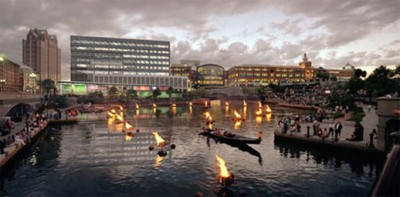The New Urban Workplace

In the industrial economy people worked in factories. In the services/information economy people worked in office parks. In the creative economy, people are working in downtowns. Rod Stevens of Spinnaker Strategies summarizes this trend quite nicely in The New Urban Workplace.
He mentions the suburbia to city downtown shift of Microsoft and Expedia in Seattle, American Eagle in Pittsburgh, AT&T in Atlanta, and Target in Minneapolis. He also highlights how these companies are recycling buildings and sites: Adidas and Amazon are in retrofitted hospitals, Pixar replaced an old Del Monte cannery and American Eagle is sited on a former steel plant.
Why the downtown migration? Rod cites statistics that more women than men are graduating from college as well as working, more workers are openly gay, and more immigrants are educated where more than half of the new companies in Silicon Valley are started by immigrants. Suburbia does not appeal to these groups, which tend to be isolating, whereas cities attract more open-minded, diverse and connected populations. And where the talent is, the companies follow. For instance, the talent-rich Carnegie Mellon University even hosts Apple, Intel and Google on campus.
The report concludes with a checklist of what to do to attract investment and talent if you’re either a company, city or college/university.
The photo above is of the new GTECH world headquarters in downtown Providence, Rhode Island – the big gray box that unfortunately looks like a corporate office building. Too bad it couldn’t look more like the building to the right, but as Steve Jobs said regarding finding a home for Pixar, “What we really wanted was to find a big, old, brick building and rehabilitate it, but we couldn’t, so we built it instead.” Maybe next time the GTECH real estate team will try a little harder. The bottom line here is who wouldn’t want to work with a scene like that in your backyard?

Leave a Reply